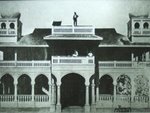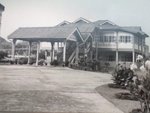In Brunei, we just do not realise sometimes how lucky we are and how rich our country is. Currently we have the oil and the natural gas. But in terms of natural resources, we still have the silica sand, the peat which can be converted into energy, the coal, the methane gas and the trees. That's why in the old days, Bruneians were great traders trading our goods far and wide. Unfortunately we seemed to have lost that skill with most of us now preferring to be civil servants, sitting down in air-conditioned rooms and pushing papers.
So what about the coal?
Coal was first reportedly found in Brunei Darussalam in the Kianggeh River by someone called Tradescent Lay as early as 1837 and attracted the attention of Americans. In 1841, an American ship ‘Constitution’ arrived in Brunei Town to negotiate a treaty of commerce and friendship but the offer was refused. The coalmine at Kianggeh was later operated by Pengiran Yusof and from 1846 to 1883, the Brunei coal deposits remained unexploited except by Bruneians for local consumption.
Coal played an important role in the world economy before oil. Steamships, trains and the engines for the industrial revolution in Europe rely on coal for their fuel. In fact the discovery of coal in Labuan in 1844 led to the British decision to annex the island from Brunei with their gunboat diplomacy forcing the Sultan to sign the agreement. When the Japanese invaded Brunei, it was not just the oil that attracted them but the coal deposits that we had in the country too.
However it was in Serai Pimping, Muara that coal was mined extensively. The Muara coalmine was first mined commercially in 1883, when William Cowie was given the concession rights to mine the coal in exchange for $1,200 per year. However Cowie later sold his rights to Rajah Charles Brooke and the Rajah renamed the mine Brooketon (Brooke Town).

Between the years of 1889 to 1924, it was operated by the Sarawak government. Annual exports of coal varied between 10,000 to 25,000 tons annually and in those 33 years of operation, more than 650,000 tons were exported. At first the mine was opencast – the early miners used changkuls (hoes), shovels and hammers – the method is simple but very slow and unproductive. With increasing demand, the operation moved underground needing larger capital and more miners.
Brooketon Colliery was strategic as it was very near to Muara where then and as well as now there is a safe deep-water anchorage to which the mine was connected via rail. With the more sophisticated mining methods, railways, wharfs and other advance equipment were needed. A rail line that connected Brooketon in Serai Pimping which is about one and a half mile away from Muara was built.
Muara itself grew. Before the mine, Muara was a small hamlet occupied by fishermen but by 1911, more than 1,447 people lived in Muara with some 30 shops operating there. Politically too, even though he only had economic rights, Rajah Charles became the ‘ruler’ of the area. The mine employed hundreds of miners and that required him to introduce a police force, post office and roads transforming Muara into an ‘extraterritorial’ settlement – an extension of Sarawak.
It was not until 1921 before Muara was ‘returned’ back to be under Brunei control. The Brooketon Colliery closed down in 1924 because of heavy financial losses caused by continuously decreasing coal prices in the world economic recession as well as the discovery and search for oil to replace coal.
The Muara coalmine opened for a short while during the Japanese occupation in the second world war but production was limited for local consumption only.
According to Brunei Shell, there is a number of other coal bearing seams throughout Brunei. A nearer one to Muara is at the Kianggeh and Mentiri Valleys and at Berambang Island. Another area in Tutong is at the Tutong and Keduan River Valleys and in Belait is the Ingei and Topi Rivers. Lumut Hills and Labu Sycnline also have it as well.
Recently the Museums Department announced that it wanted to turn the historical 62 hectares coal mine as an open site museum to promote the country's eco tourism. The Brooketon coalmine is currently already a protected site under the Antiquities and Treasure Trove Act. Maybe one day, Brunei can mine the coal again. In the meantime, it is being kept as one of Brunei’s treasures and legacy for the future.
Note: An edited version of the above article was published in The Golden Legacy column in The Brunei Times dated 14th April 2007.












No comments:
Post a Comment